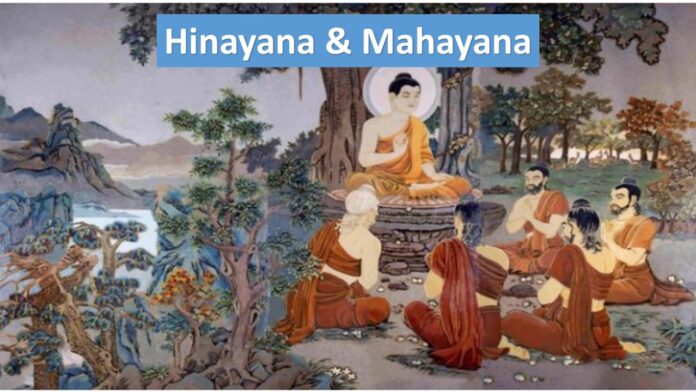The death of Buddha gave a new path for Buddhism as it was divided into two separate sectors known as Hinayana and Mahayana. These terms originated from the Prajaparamita Sutras, which represent two dishonoring terms putting down Hinayana and placing Mahayana on top.
By Prathima.G.Kulkarni
Hinayana is referred to as Lesser Vehicle or Modest Vehicle and Mahayana is a Greater Vehicle or Vast Vehicle as prescribed in Prajaparamita Sutras. The term Prajaparamita Sutra refers to as “Perfection of Wisdom”.
Hinayana Buddhism
Hinayana is the original teachings of Buddha which focus on Individual salvation achieved from self-discipline and meditation. The lesser Vehicle or most Modest Vehicle is introduced as becoming aware actuality that what we experience in Samsara is referred to as suffering. This awareness will help to eliminate oneself suffering so that one could liberate oneself at an individual level to attain happiness. Hinayana followers do not believe in Idol worship ,and the main aim is to attain Nirvana. Sarvastivada and Theravada is a sect of Hinayana.
Theravada Buddhism also known as the doctrine of the elders which is one of the oldest in Buddhism’s three major sects. It is told to be the closest to the one taught by Buddha himself. The name Theravada means “The doctrine of the elders”. The elders mentioned are senior Buddhist monks. The monks live in monastic communities where they practice and teach. There is no age limit to join. Even a seven-year-old could join a person of any age. The new person who joins is called a Samanera and a full monk is called Bikkhu.
Sarvastivada Buddhism which means “Doctrine that all is real” is known as the early school of Buddhism. The principal concept of Sarvastivada is the assumption of the existence of Dharmas, Cosmic factors, and other events which combine for time being with a person’s past deeds to understand the person’s life purpose.
Mahayana Buddhism
Mahayana Buddhism found its root within Indian Buddhism around the beginning of the Common Era and became a dominant influence by the 9th century on the Buddhist cultures of Central and East Asia, which remains even today. Mahayana believes in the heavenliness of Buddha which refers to worshipping one own body as it is the powerhouse. The monks of this form follow the Idol worship of Buddha. It consists of many schools and importance is given to the reinterpretations of fundamental human beliefs, values, and ideals not only those of the Buddhist teachings. It is said that Mahayana started during the 2nd century CE.
The Bodhisattva which refers to the human being, who devotes him or herself to the service of others, became the new model for religious practice. The term Mahayana was first mentioned in the Lotus Sutra which mentions the date between the 5th and 1st century CE. In this era, the natural law of all existence according to Buddhism was no longer considered a theological element but a medicine that would heal all worldly suffering.
Difference between Mahayana and Hinayana Buddhism
Mahayana followers worship the bodhisattvas and read the Mahayana sutras while Hinayana followers do not perform these.
Mahayana Buddhism followers think that The Buddha is a God because they think that the Buddha came down to earth to help people cross the sea of life. Hence they believe that Buddha can be worshipped as a God and worship the idol of Buddha. Hinayana Buddhists think that Buddha was a Human and not God because they think Buddha was simply a man who found a way to Nirvana.
Hinayana Buddhists think that Buddha is an ordinary person because he had human-like characteristics such as he looked like a person, being born like a person, and living like a person. They also think that if he was a God he would have known about old-aged people, diseased people, and dead people.
The early writings of Hinayana were in Pali where as Mahayana was written in Sanskrit. Hinayana Buddhism is followed as philosophy and Mahayana followed the reference to the higher beings, more like a religion.








